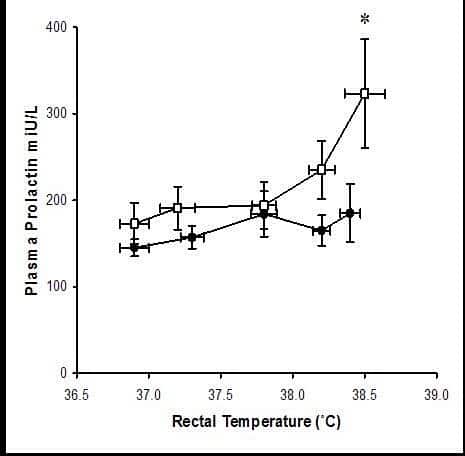Compared to cool conditions, exercise undertaken in the heat is associated with higher ratings of perceived exertion (RPE) and a greater neuroendocrine response, as evidenced by levels of circulating prolactin (PRL). For the same core temperature, exercise in the cool environment has lower RPE and PRL values (Bridge et al, 2003) suggesting that skin temperature may modulate the response to raised core temperature and that there may be a common mechanism linking the RPE and PRL responses. The face may be particularly effective in mediating the PRL response to skin cooling (Brisson et al, 1991) and we have investigated whether face cooling alone has similar effects on RPE and PRL responses to hyperthermic exercise. Following Local Ethics Committee approval and obtaining informed consent, ten, non heat-acclimatised volunteers (8 male, 19-26years; VO2max: 55±2 mlnull;kgnull;min-1) exercised for 40 min on a cycle ergometer at 65% maximum power output, at an ambient temperature of 35°C (relative humidity: 30%) with (FC) and without face-cooling (CON), in a randomised cross-over design. Forehead temperature was maintained ~6°C lower with FC whilst mean skin temperature for other parts of the body was ~0.5°C higher. A relative bradycardia was observed with heart rate during FC being approximately 5 bpm lower than CON. Blood glucose did not differ between trials but lactate was lower with face-cooling (FC 5.1±0.6; Con 6.5±0.7 mmol/l). Rectal temperature increased by 1.5±0.1°C with the same time course in both conditions. Levels of prolactin were maintained at ~150 miU/L for FC while values for CON increased to ~350miU/L so that towards the end of the exercise, for the same rectal temperature, PRL was significantly lower in the FC condition (Fig. 1; p<0.05; repeated measures ANOVA). No differences were observed between trials for global RPE although a separate rating for ventilation was reduced with FC. We confirm that the neuroendocrine response to exercise in the heat is sensitive to face cooling but find that the temperature of the face may be only one component of the overall perception of exertion when exercising in hot conditions.
King's College London (2005) J Physiol 565P, C31
Communications: The Effects of Face-Cooling on the Perception of Exertion and Neuroendocrine Response to Hyperthermic Exercise
Mundel, Toby ; Hooper, Paula ; Bunn, Sabrina ; Jones, David ;
1. Sport and Exercise Sciences, University of Birmingham, Birmingham, United Kingdom.
View other abstracts by:
Fig. 1 Plasma prolactin concentrations in relation to rectal temperature during exercise at 35□CON; ●FC. Data are mean + S.E.M. *Indicates value significantly higher than FC p<0.05.
Where applicable, experiments conform with Society ethical requirements.

